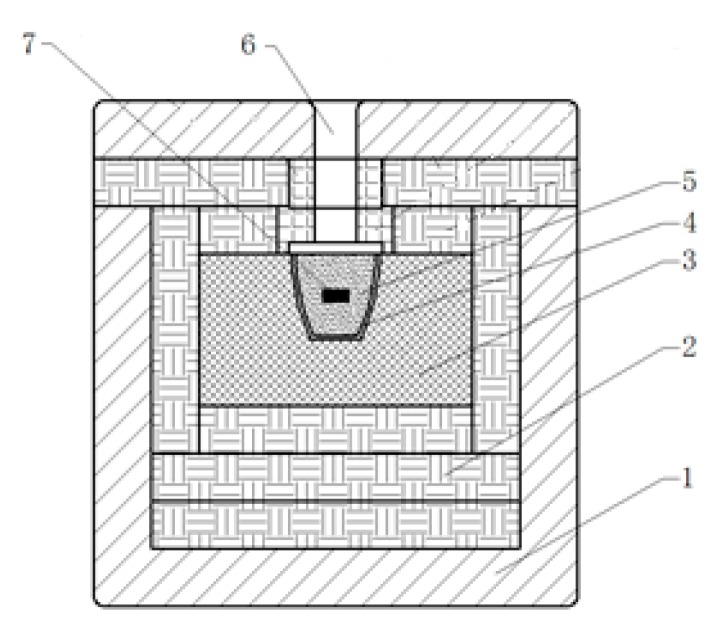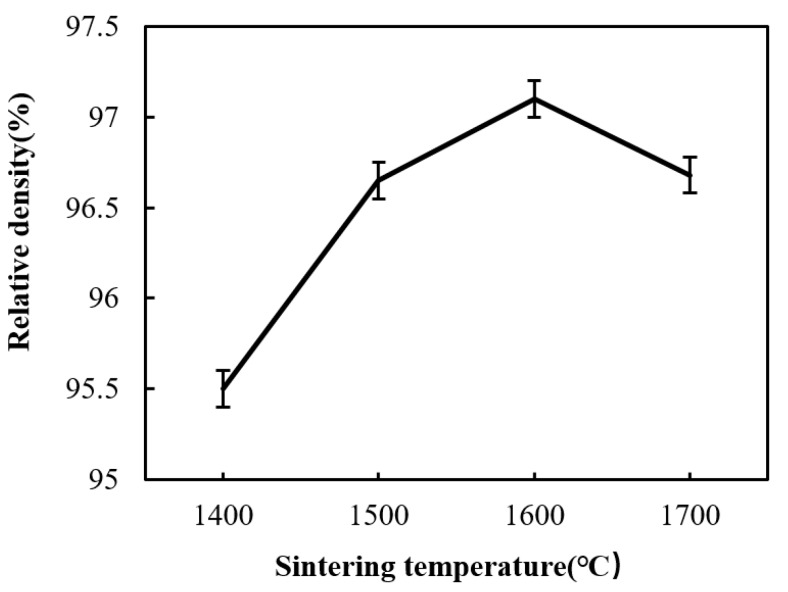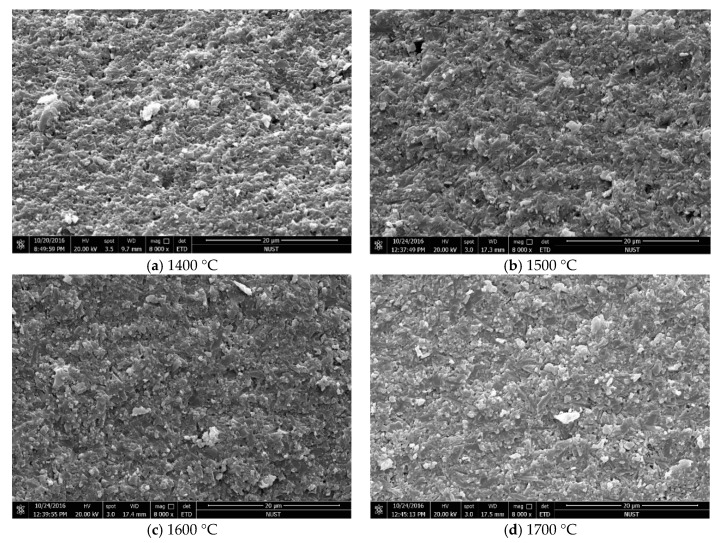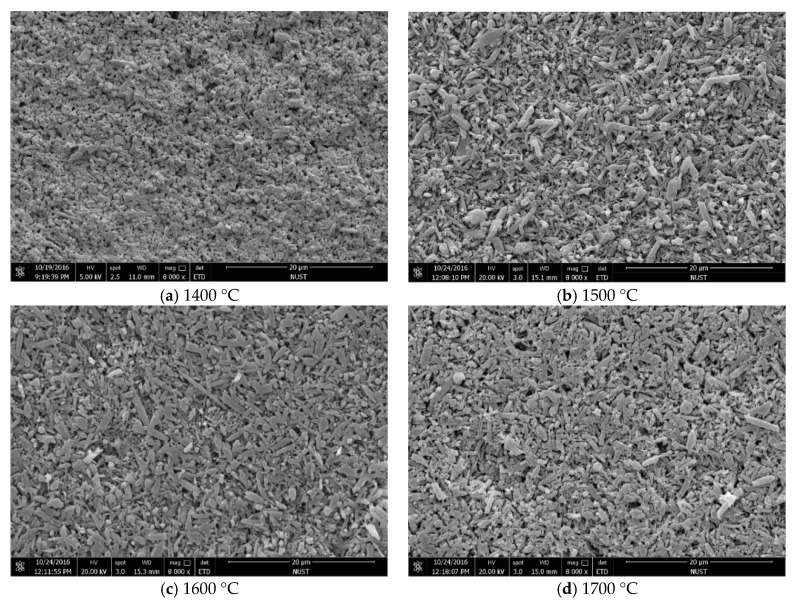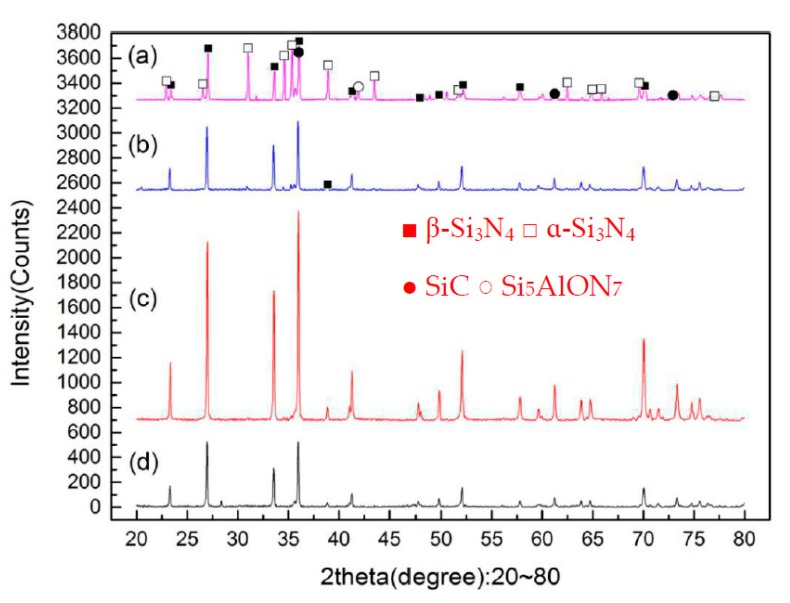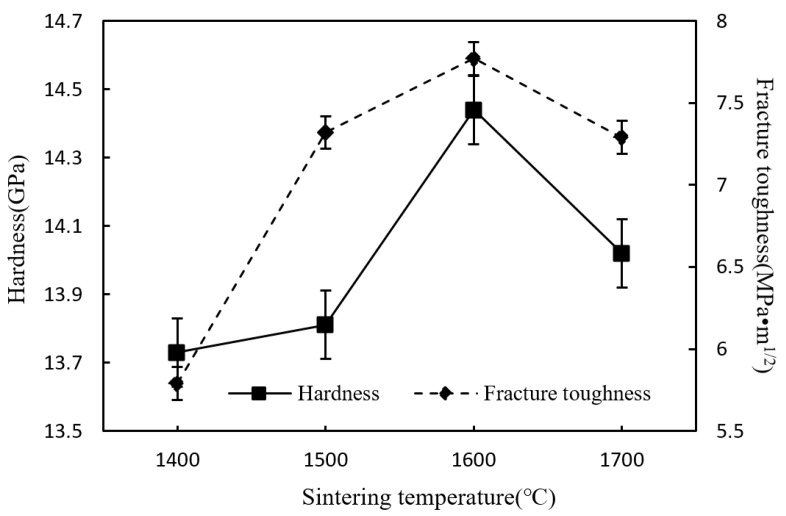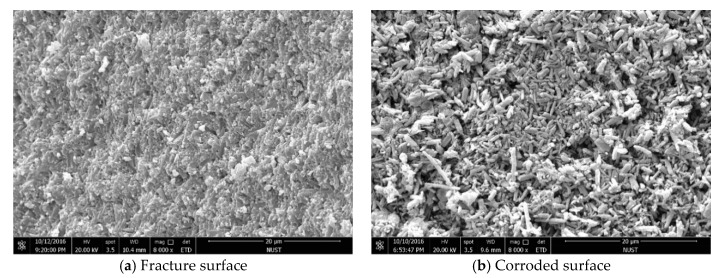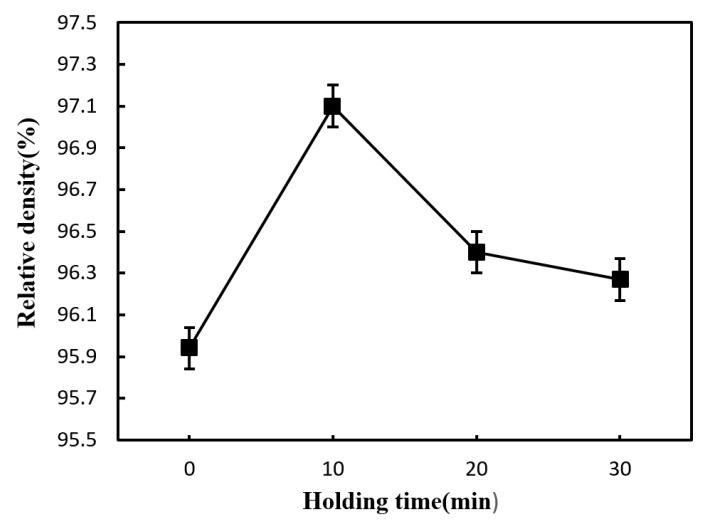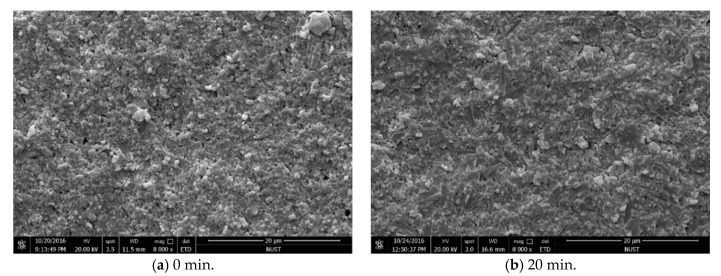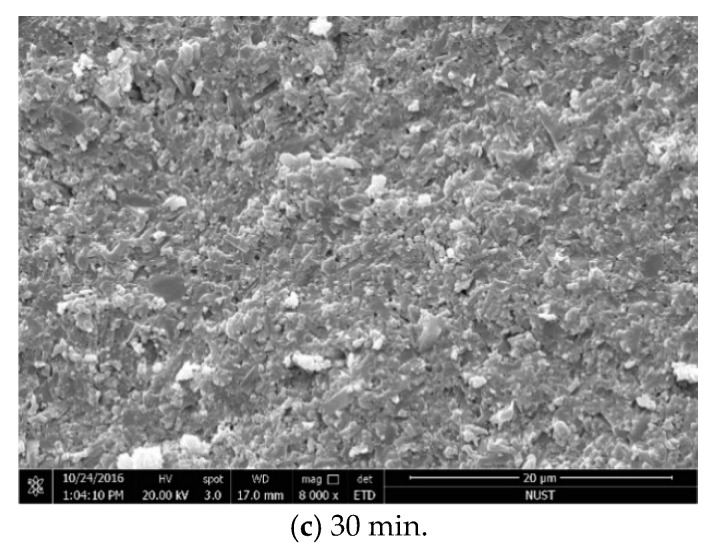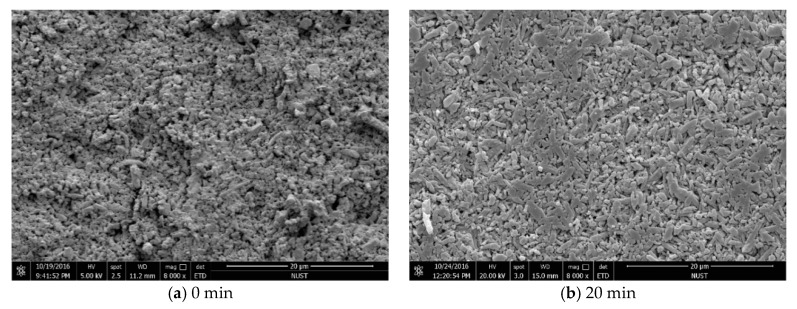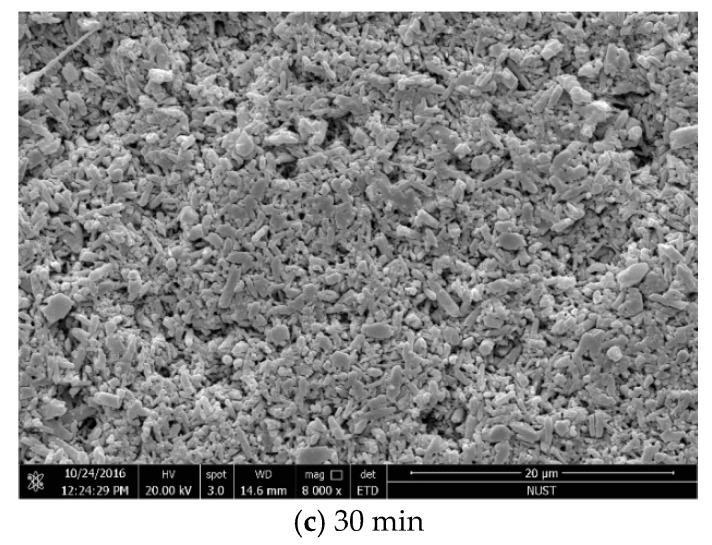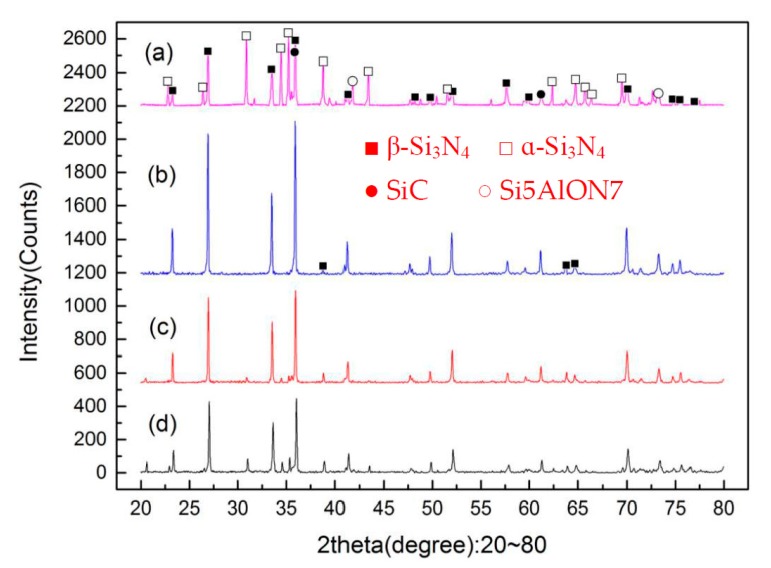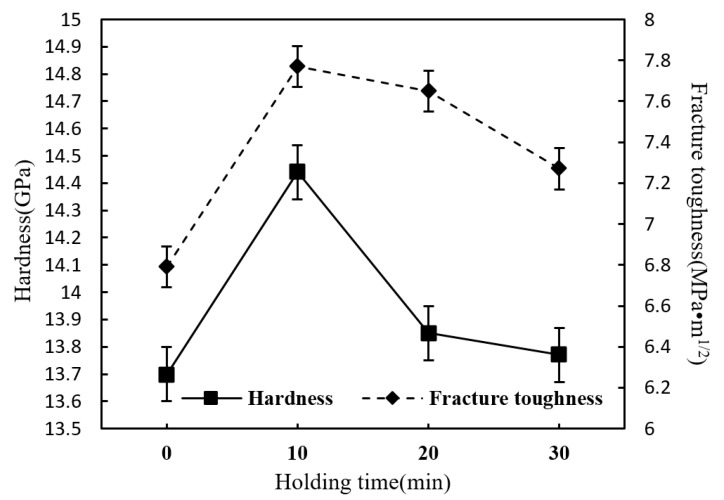Abstract
The n-SiC (nanometer SiC) is added to be the additive in order to improve the mechanical performance of Si3N4 ceramics. A microwave sintered the ceramics at different temperature and holding times. The results shows that the Si3N4/n-SiC ceramics (85 wt% Si3N4 + 5 wt% n-SiC + 5 wt% Al2O3 + 5 wt% Y2O3) have the best mechanical properties at 1600 °C, which is beneficial to the densification and β-Si3N4 phase formation for 10 min: the density, hardness, and fracture toughness were 97.1%, 14.44 GPa, and 7.77 MPa·m1/2, which increased by 2.8%, 7.0%, and 13.1%, respectively, when compared with the ceramics (90 wt% Si3N4 + 5 wt% Al2O3 + 5 wt% Y2O3).
Keywords: Si3N4 ceramics, n-SiC, microwave sintering, mechanical properties, microstructure
1. Introduction
Si3N4 ceramic have been widely recognized as the ideal tool materials for cutting the high temperature cast iron and nickel-based alloys due to its outstanding thermal properties, wear resistance, and high temperature material properties [1,2,3,4]. Currently, high-performance densified Si3N4 ceramics are usually sintered by hot pressing sintering [5,6], hot isostatic pressure sintering [7], pressure less sintering [8], microwave sintering [3,4], reaction sintering [9,10], and spark plasma sintering [11,12,13]. Among the mentioned methods, microwave sintering is a new technology, which has high-energy utilization rate, safety, and free pollution. Many researches have shown that it can not only promote the densification of sintered materials to short the sintering time, but also refine the crystalline microstructure [14,15,16,17]. Besides, it is a kind of pressure less sintering, which makes it possible to massively produce ceramic tools with complex shapes.
However, the microwave absorption of Si3N4 at low temperature (less than 800 °C) is poor [18], which affects the microwave sintering process. The fracture toughness of Si3N4 ceramic is usually between 5.0 MPa·m1/2 and 7.0 MPa·m1/2 with high hardness [3,13,14,15,16,17], which should be improved to meet the requirements of high-performance cutting tools. When considering that n-SiC has good microwave absorption properties and high hardness at all temperature stages [18], it is added into silicon nitride ceramics. On the one hand, the uniform distributed n-SiC particles can be used as strengthening phase to improve the fracture toughness of the ceramics. On the other hand, the n-SiC particles are equivalent to many small heat sources during the sintering process, which improve the sintering properties and promote the α→β phase transformation of the Si3N4.
Al2O3 and Y2O3 were the most common additives that were used in the conventional sintering of Si3N4 ceramics according to the existing reports [19,20,21,22,23]. In the field of microwave sintering, Al2O3 and Y2O3 were also used as sintering additives, for example, Tiegs et al. [24] successfully sintered silicon nitride ceramic material with the density of 96% by microwave sintering while using 12 wt% Y2O3 and 4 wt% Al2O3 as sintering additives. Yoon et al. [14] fabricated Si3N4 ceramic materials with a density of 99% at a sintering temperature of 1600 °C while using Al2O3 and Y2O3 as sintering additives. As a result of that these two kinds of sintering additives can contribute to the formation of the liquid phase, which can promote the densification of Si3N4 ceramics, we selected these sintering aids in our research. The study was aimed to prepare high-performance Si3N4/n-SiC ceramics, with Al2O3 and Y2O3 as sintering aids, by microwave. The effects of sintering temperature and holding time on the properties of microwave sintered Si3N4/n-SiC ceramics were analyzed. SEM microstructure analysis, X-ray diffraction (XRD) phase analysis, density, and hardness and fracture toughness.
2. Experimental Procedure
The starting powders (99.9% purity, Shanghai, China) were used as: α-Si3N4 (0.7 μm), n-SiC (0.1 μm), Y2O3 (1 μm), and Al2O3 (0.5 μm). Firstly, the starting powders that were in isopropyl alcohol were placed on a planetary ball mill (QM-3SP2, Nanjing university instrument factory, Nanjing, China) for 48 h. Subsequently, the 3 wt% polyvinyl alcohol solution was added to the mixed slurry and the ball milling was continued to ball mill for 2 h. After that, the powders were then pressurized under 180 MPa for 2 min and finally turned into a green body that has a certain shape and density, and it was sintered in a multimode high temperature vacuum microwave oven filled with N2. Figure 1 shows the heat preservation device for sample. Table 1 lists the compositions, sintering temperature, and holding time of Si3N4 materials. T 90 wt% Si3N4 + 5 wt% Al2O3 + 5 wt% Y2O3 is taken as a comparison to illustrate the effectiveness of n-SiC on the properties of Si3N4 ceramics.
Figure 1.
Heat preservation device (1—Mullite box, 2—Aluminium silicate, 3—Polycrystalline mullite fiber cotton, 4—Crucible, 5—Silicon carbide powder, 6—Hole for infrared temperature, and 7—Specimen).
Table 1.
The sintering temperature and holding time of the series ceramic materials.
| Test No. | Compositions/wt% | Temperature/°C | Holding Time/min |
|---|---|---|---|
| 1 | 85% Si3N4 + 5% SiC + 5% Al2O3 + 5% Y2O3 | 1400, 1500, 1600, 1700 | 10 |
| 2 | 85% Si3N4 + 5% SiC + 5% Al2O3 + 5% Y2O3 | 1600 | 0,10,20,30 |
| 3 | 90% Si3N4 + 5% Al2O3 + 5% Y2O3 | 1600 | 10 |
The density of the sintered specimens was measured by the Archimedes drainage method with distilled water. According to the method in [25], the grain size analysis is carried on. After grinding and polishing by a diamond quadrilateral indenter (HV-50, Insize, Shanghai, China) under 196.1 N load the Vickers hardness (Hv) was tested. Fracture toughness was determined while using the indentation technique in [26]. The phase composition of the sample before and after sintering was analyzed via X-ray diffractometric (D8 Advance, Bruker, Karlsruhe, Germany). The relative amounts of the α-Si3N4 and β-Si3N4 phases that were presented in the Si3N4 specimen were determined according to the peak height [27]. The microstructures of the samples were observed by Scanning electron microscopy (SEM, FEI Quanta 250F, FEI, Hillsboro, OR, USA).
3. Results and Discussion
3.1. Effect of Sintering Temperature
Figure 2 shows the he relative density increases first and then decreases with the increase of sintering temperature, the minimum relative density reached the minimum value 95.5%, and the maximum value 97.1% at 1400 °C and 1600 °C, respectively. As shown in Figure 3a, there are still many porosities in the sintered Si3N4/n-SiC ceramics materials at 1400 °C. This is mainly because enough liquid phases inside the sintered ceramics material cannot be formed to complete sintering at a low temperature. Figure 3b–d indicate that the porosity of the sintered Si3N4/n-SiC ceramics material was obviously reduced with as the sintering temperature increases and the material structure is more compact than that at 1400 °C. The results show that the sintering additives (5 wt% Al2O3 and 5 wt% Y2O3) were able to form a sufficient liquid phase with the increase of temperature during the sintering process. The sufficient liquid phase further promotes the particles motion (Si3N4 and n-SiC) and the shrinkage of the green compact, thus the densification of sintered ceramic materials was improved. However, when the sintering temperature reaches to 1700 °C, the relative density of sintered ceramic materials slightly decrease. It can be explained that, with the increase of sintering temperature, the β-Si3N4 phase gradually increases and grows, and the interlocking structure is formed, which causes the increase of the porosity and the decrease of the relative density. Another possible explanation might be the errors introduced in the process of temperature measurement. High temperature (over 1800 °C) will cause the decomposition of silicon nitride, which leads to the decrease of relative density [28]. In addition, due to the good microwave absorbing property of SiC, the temperature of the n-SiC particles is higher than the Si3N4 particles’ during microwave sintering; therefore, a local high temperature region is formed around the n-SiC particles. The local high temperature can promote the densification of sintered material and the α→β phase transformation of Si3N4. However, if the local temperature is above 1800 °C, the Si3N4will decompose.
Figure 2.
The relationship between the relative density and sintering temperature (holding for 10 min).
Figure 3.
The Scanning electron microscopy (SEM) micrographs of the fracture surface of the sintered Si3N4/n-SiC ceramics at different sintering temperatures (holding time for 10 min).
Figure 4 shows the SEM micrographs of the sintered Si3N4/n-SiC ceramics at different temperatures. Figure 5 shows the XRD results of the sintered Si3N4/n-SiC materials. As it can be seen in Figure 4a, there is a small amount of long columnar structure and lots of powder or irregular shape, which is formed by grains of sintered material, when the temperature is 1400 °C. Figure 5a shows that the sintered samples mainly consist of α-Si3N4, β-Si3N4, SiC, and Si5AlON7 at 1400 °C. The ratios of α-Si3N4 and β-Si3N4 in the Si3N4 ceramics are 52% and 48%, respectively. This further indicates that there are not enough liquid phases, which are used to promote the sintering densification and the transformation of α-Si3N4 to β-Si3N4, at a relatively low sintering temperature. As shown in Figure 4b, most of the α-Si3N4 is transformed into a long columnar β-Si3N4 at 1500 °C, and there is only a small amount of α-Si3N4 in the sintered Si3N4/n-SiC ceramics, as shown in Figure 5. However, the crystal size of β-Si3N4 is different, there are some silicon nitride grains that grow more completely, and presenting larger grains size, and there are also many small columnar grains. As can be seen from Figure 4c, the grains of β-Si3N4 were further grown and formed a large number of big columnar grains with an average grain length of 3.25 μm at 1600 °C. As shown in Figure 4d, the surface of some β-Si3N4 grains is not smooth, and there is especially the tendency that some β-Si3N4 grains are going to turn to powder, when the temperature is 1700 °C. It is further indicated that Si3N4 has the possibility of decomposition at this temperature, which reduces the mechanical properties and densification of the sintered Si3N4/n-SiC ceramics. According to the XRD diffraction pattern (Figure 5), the α-Si3N4 phase is completely transformed into a β-Si3N4 phase in sintered Si3N4/n-SiC ceramics when the sintering temperature is above 1600 °C.
Figure 4.
SEM micrographs of the fracture surface morphology of the samples after molten NaOH corrosion at different sintering temperatures (holding time for 10 min).
Figure 5.
The X-ray diffraction (XRD) results of the sintered Si3N4/n-SiC ceramics at different sintering temperatures (holding time for 10 min), (a) 1400 °C, (b) 1500 °C, (c) 1600 °C, and (d) 1700 °C.
As shown in Figure 6, the hardness and fracture toughness increase first and then decrease as the sintering temperature increased. The change trend of the Vickers hardness and fracture toughness is the same as relative density. It indicates that the high densification can significantly improve the mechanical performances of the sintered Si3N4/n-SiC ceramics. When the temperature is 1600 °C, the Vickers hardness and fracture toughness reached a maximum value of 14.44 GPa and 7.77 MPa·m1/2, respectively. As can be seen from Figure 3c and Figure 4c, the sintered Si3N4/n-SiC ceramics were densified and formed many interlocking elongated columnar β-Si3N4 grains. The main fracture mechanisms of the sintered Si3N4/n-SiC ceramics are intergranular fracture, transgranular fracture, and grain pulling out. The interlocking microstructure that formed by large elongated columnar β-Si3N4 grains can greatly enhance the mechanical properties, especially the fracture toughness of silicon nitride materials. Therefore, when the temperature exceeds 1500 °C, a great quantity of elongated columnar β-Si3N4 grains is formed, which significantly improves the fracture toughness (more than 7.0 MPa·m1/2) of the material.
Figure 6.
Effect of sintering temperature on hardness and fracture toughness (holding time for 10 min).
Table 2 shows the comparison of properties of Si3N4 with n-SiC content of 0% and 5% at 1600 °C for 10 min. When n-SiC is not added into the sintered silicon nitride materials, the density, Vickers hardness, and fracture toughness of the Si3N4 ceramics are 94.5%, 13.5 GPa, and 6.87 MPa·m1/2, which increased by 2.6%, 7.0%, and 13.1%, respectively. Figure 7 is SEM micrographs of the fracture surface morphology of the Si3N4 material with 0% n-SiC content. As shown in Figure 7, when the n-SiC content is 0%, there are great quantities of small porosities in the sintered Si3N4 ceramics. Additionally, the distribution and size of the β-Si3N4 grains are uneven. The results showed that the filling of SiC nanopowders evidently improved the microwave sinter ability of Si3N4 ceramics.
Table 2.
Comparison of properties of Si3N4 with SiC nanopowders content of 0% and 5% at 1600 °C for 10 min (wt%).
| Number | n-SiC Content/wt% | Relative Densty/% | Hardness/GPa | Fracture Toughness/MPa·m1/2 |
|---|---|---|---|---|
| 1 | 0 | 94.5 | 13.50 | 6.87 |
| 2 | 5 | 97.1 | 14.44 | 7.77 |
Figure 7.
SEM micrographs of fracture surface morphology of the Si3N4 material (0 wt%) at 1600 °C for 10 min.
3.2. Influence of Holding Time on the Properties of Si3N4/n-SiC Ceramics
Figure 8 shows the influence of holding time on the density of the sintered Si3N4/n-SiC ceramic at 1600 °C. As shown in Figure 8, the relative density increases first and then decreases as the holding time increased. The density reaches the maximum value of 97.1% when the holding time is 10 min. Figure 3c shows that the microstructure of the sintered Si3N4/n-SiC ceramic is more compact at this condition. Figure 9 presents SEM micrographs of fracture surface morphology of the Si3N4/n-SiC ceramic at 1600 °C under different holding time. As shown in Figure 9a, the microstructure of the sintered Si3N4/n-SiC ceramic is loose when the holding time is 0 min. It can be seen that the sintered Si3N4/n-SiC ceramic is not completely sintered under this condition. As shown in Figure 8b,c, there are many evenly distributed porosities in the sintered Si3N4/n-SiC ceramic when the holding time is 20 min and 30 min, respectively. The main reason is that the elongated columnar β-Si3N4 grains grow with the increase of holding time, which results in a large number of porosities among the big β-Si3N4 grains.
Figure 8.
Effect of holding time on the relative density of the sintered Si3N4/n-SiC ceramic at 1600 °C.
Figure 9.
SEM micrographs of fracture surface morphology of the sintered Si3N4/n-SiC ceramic at different holding time (sintering temperature for 1600 °C).
Figure 10 presents SEM micrographs of the sintered Si3N4/n-SiC ceramics at different holding time. Figure 11 is the XRD results of Si3N4/n-SiC ceramics at different holding time. As shown in Figure 10a, when the holding time is 0 min, most of the grains in the sintered Si3N4/n-SiC ceramics are spherical and powdery, and only a small amount of grains are columnar grains. The average grain size is 0.92 μm, which is nearly the same as that of the starting α-Si3N4 powder (0.7 μm). Figure 11a shows that the Si3N4/n-SiC ceramics material is not completely sintered due to the short holding time (0 min). As shown in Figure 4c and Figure 11b, the α-Si3N4 phase is almost completely transformed into the elongated columnar β-Si3N4 phase in the sintered Si3N4/n-SiC ceramics when the holding time is 10 min. As shown in Figure 10b,c, the distribution of β-Si3N4 crystal size is uneven when the holding time is more than 10 min, the reasonable explanations is that someβ-Si3N4 grains grow too large to occupy the growing space for other grains. Figure 10c shows that there are some larger holes or pits on the etched surface of the sintered Si3N4/n-SiC ceramics. It is a possible explanation that the liquid phase is connected to one piece for the long holding time, which causes some Si3N4 grains to fall off with the dissolution of the liquid phase during the molten NaOH corrosion process to form holes or pits.
Figure 10.
SEM micrographs of the fracture surface morphology of the samples after molten NaOH corrosion at different holding time (sintering temperature for 1600 °C).
Figure 11.
XRD results of the sintered Si3N4/n-SiC ceramics at different holding time (sintering temperature for 1600 °C), (a) 0 min, (b) 10 min, (c) 20 min, and (d) 30 min.
Figure 12 shows the influence of different holding time on the Vickers hardness and fracture toughness of Si3N4/n-SiC ceramics at a constant temperature of 1600 °C. As can be seen from it, the hardness and fracture toughness are both gradually rising first and then falling over time, and it is clear that they both reach their maximum value, 14.44 GPa and 7.77 MPa·m1/2, respectively, after the ceramics having been sintered for 10 min. It turns out that the very first ten minutes of the thermal insulation stage plays a key role in improving the microstructure and mechanical performances of the microwave sintered Si3N4/n-SiC ceramics, while a longer holding time, which is more than 10 min, will result in abnormal grain growth, uneven grain size and pores, and finally lead to a degradation in material properties, according to the experiments.
Figure 12.
Effect of holding time on hardness and fracture toughness of the sintered Si3N4/n-SiC ceramics (sintering temperature for 1600 °C).
Table 3 lists the relative density and mechanical performances of other Si3N4 materials with different sintering aids and sintering methods. It can be seen that the results vary in not only the different sintering methods based sintering processes, but also the processes using the same sintering method. When compared with the listed results in Table 3, the fracture toughness of newly proposed microwave sintered Si3N4/n-SiC ceramics have obtained an increase of 12.8–27.4%. It is safe to say that preparing high-performance ceramic materials is of great significance with the rapid development of microwave sintering technology.
Table 3.
Comparison of mechanical properties of silicon nitride.
| Additives | Sintering Method | Sintering Temperature/°C | Holding Time/min | Relative Density/% | Hardness/GPa | Fracture Toughness/MPa·m1/2 |
|---|---|---|---|---|---|---|
| 5 wt% Y2O3 + 5 wt% MgO + 2 wt% Al2O3 [3] | Microwave | 1700 | 10 | 98.52 | 14.92 | 6.44 |
| 3 wt% MgO + 1.5 wt% Al2O3 + 3.5 wt% SiO2 [29] | Pressureless | 1780 | 180 | 99.70 | 14.20 | 6.40 |
| 5 wt% MgSiN2 + 3 wt% Y2O3 + 1 wt% CeO2 [13] | Spark plasma | 1650 | 6 | 99.40 | 16.53 | 6.89 |
| 10 wt% LiYO2 + 5 wt% ZrO2 [30] | Microwave | 1600 | 15 | 93.00 | 13.00 | 6.10 |
4. Conclusions
In this paper, the microwave sintering process of the Si3N4/n-SiC ceramics (85 wt% Si3N4 + 5 wt% n-SiC + 5 wt% Al2O3 + 5 wt% Y2O3) was studied, focusing on the effects of a different temperature and holding time on the properties and microstructure. The major conclusions that are derived from this study are as follows:
A certain sintering temperature around 1600 °C is necessary for the densification and β-Si3N4 phase formation of the Si3N4/n-SiC ceramics. Held at a temperature below 1500 °C, the Si3N4/n-SiC ceramics cannot be completely sintered. However, a higher temperature over 1700 °C, can cause the decomposition of Si3N4 or Si3N4’s reacting with sintering aids (Al2O3 and Y2O3), which will lead to the decrease of density, Vickers hardness, and fracture toughness of the Si3N4/n-SiC.
The density, hardness, and fracture toughness will all gradually degrade if the Si3N4/n-SiC ceramics are sintered with microwave exceeding 10 min. Although the long holding time makes some β-Si3N4 grains grow larger, it also causes the uneven size of the β-Si3N4 grain, and pores appear between the big grains at the same time. Accordingly, it can be concluded that the microwave sintered Si3N4/n-SiC ceramics should not be held for too long. In this paper, the optimum holding time of microwave sintered Si3N4/n-SiC ceramics is presented to be 10 min at 1600 °C.
The microwave sintered Si3N4/n-SiC ceramics have the best mechanical performances at a sintering temperature of 1600 °C for 10 min, with the density being 97.1%, the Vickers hardness being 14.44 GPa, and the fracture toughness reaching 7.77 MPa·m1/2, which increases by 2.8%, 7.0%, and 13.1%, respectively, when compared with the microwave sintered Si3N4 ceramics (90 wt% Si3N4 + 5 wt% Al2O3 + 5 wt% Y2O3).
Author Contributions
Conceptualization, J.Y.; data curation, T.L.; writing—original draft preparation, L.Q.; writing—review and editing, Z.W.
Funding
This work is supported by National Natural Science Foundation of China (51775280 and 51675285), and the Jiangsu Provincial Six Talent Peaks Project.
Conflicts of Interest
The authors declare no conflict of interest.
References
- 1.Riley F.L. Silicon nitride and related materials. J. Am. Ceram. Soc. 2000;83:245–265. doi: 10.1111/j.1151-2916.2000.tb01182.x. [DOI] [Google Scholar]
- 2.Miranzo P., González-Julián J., Osendi M.I., Belmonte M. Enhanced particle rearrangement during liquid phase spark plasma sintering of silicon nitride-based ceramics. Ceram. Int. 2011;37:159–166. doi: 10.1016/j.ceramint.2010.08.019. [DOI] [Google Scholar]
- 3.Xu W.W., Yin Z.B., Yuan J.T., Wang Z.H., Fang Y.H. Effects of sintering additives on mechanical properties and microstructure of Si3N4 ceramics by microwave sintering. Mater. Sci. Eng. A. 2017;684:127–134. doi: 10.1016/j.msea.2016.12.031. [DOI] [Google Scholar]
- 4.Xu W.W., Yin Z.B., Yuan J.T., Wang Z.H., Liu Y. Preparation and characterization of Si3N4-based composite ceramic tool materials by microwave sintering. Ceram. Int. 2017;43:16248–16257. doi: 10.1016/j.ceramint.2017.08.209. [DOI] [Google Scholar]
- 5.Guo W.M., Wu L.X., Ma T., Gu S.X., You Y., Lin H.T., Wu S.H., Zhang G.J. Chemical reactivity of hot-pressed Si3N4-ZrB2 ceramics at 1500–1700 °C. J. Eur. Ceram. Soc. 2015;35:2973–2979. doi: 10.1016/j.jeurceramsoc.2015.04.031. [DOI] [Google Scholar]
- 6.Miyazaki H., Hyuga H., Yoshizawa Y.I., Hirao K., Ohji T. Correlation of wear behavior and indentation fracture resistance in silicon nitride ceramics hot-pressed with alumina and yttria. J. Eur. Ceram. Soc. 2009;29:1535–1542. doi: 10.1016/j.jeurceramsoc.2008.08.020. [DOI] [Google Scholar]
- 7.Tapaszto O., Kun P., Weber F., Gergely G., Balazsi K., Pfeifer J., Arató P., Kidari A., Hampshire S., Balázsi C. Silicon nitride based nanocomposites produced by two different sintering methods. Ceram. Int. 2011;37:3457–3461. doi: 10.1016/j.ceramint.2011.05.150. [DOI] [Google Scholar]
- 8.Liu T.T., Jiang C.F., Guo W. Effect of CeO2 on low temperature pressureless sintering of porous Si3N4 ceramics. J. Rare Earths. 2017;35:172–176. doi: 10.1016/S1002-0721(17)60896-2. [DOI] [Google Scholar]
- 9.Alem A., Pugh M.D., Drew R.A. Reaction bonded silicon nitride foams: The influence of iron disilicide on microstructure and mechanical strength. Ceram. Int. 2015;41:4966–4974. doi: 10.1016/j.ceramint.2014.12.060. [DOI] [Google Scholar]
- 10.Logesh G., Lodhe M., Balasubramanian M. Effect of temperature and gaseous medium on the evolved microstructures of carbon fiber reinforced reaction bonded silicon nitride composites. Ceram. Int. 2017;43:6110–6116. doi: 10.1016/j.ceramint.2017.02.004. [DOI] [Google Scholar]
- 11.Khajelakzay M., Bakhshi S.R., Borhani G.H., Ramazani M. Synthesis and spark plasma sintering of the α-Si3N4 nanopowder. Ceram. Int. 2016;42:14867–14872. doi: 10.1016/j.ceramint.2016.06.123. [DOI] [Google Scholar]
- 12.Peng G.H., Li X.G., Liang M., Liang Z.H., Liu Q., Li W.L. Spark plasma sintered high hardness β-Si3N4 composites with MgSiN2 as additives. Scr. Mater. 2009;61:347–350. doi: 10.1016/j.scriptamat.2009.04.007. [DOI] [Google Scholar]
- 13.Cao L.Y., Wang Z.H., Yin Z.B., Liu K., Yuan J.T. Investigation on mechanical properties and microstructure of silicon nitride ceramics fabricated by spark plasma sintering. Mater. Sci. Eng. A. 2018;731:595–602. doi: 10.1016/j.msea.2018.06.093. [DOI] [Google Scholar]
- 14.Kim Y.C., Kim C.H., Kim D.K. Effect of microwave heating on densification and α→β phase transformation of silicon nitride. J. Eur. Ceram. Soc. 1997;17:1625–1630. doi: 10.1016/S0955-2219(97)00026-5. [DOI] [Google Scholar]
- 15.Chockalingam S., Earl D.A. Mechanical properties of 2.45 GHz microwave sintered Si3N4–Y2O3–MgO–ZrO2 system. J. Eur. Ceram. Soc. 2009;29:2037–2043. doi: 10.1016/j.jeurceramsoc.2009.01.006. [DOI] [Google Scholar]
- 16.Jones M.I., Valecillos M., Hirao K. Densification behavior in microwave-sintered silicon nitride at 28 GHz. J. Am. Ceram. Soc. 2001;84:2424–2426. doi: 10.1111/j.1151-2916.2001.tb01025.x. [DOI] [Google Scholar]
- 17.Jones M.I., Valecillos M.C., Hirao K., Yamauchi Y. Grain growth in microwave sintered Si3N4 ceramics sintered from different starting powders. J. Eur. Ceram. Soc. 2002;22:2981–2988. doi: 10.1016/S0955-2219(02)00054-7. [DOI] [Google Scholar]
- 18.Luo H., Chen W.B., Zhou W., Long L., Deng L., Xiao P., Li Y. Carbon fiber/Si3N4 composites with SiC nanofiber interphase for enhanced microwave absorption properties. Ceram. Int. 2017;43:12328–12332. doi: 10.1016/j.ceramint.2017.06.096. [DOI] [Google Scholar]
- 19.Han I., Seo D., Kim S., Hong K., Guahk K.H., Lee K.S. Properties of silicon nitride for aluminum melts prepared by nitrided pressureless sintering. J. Eur. Ceram. Soc. 2008;28:1057–1063. doi: 10.1016/j.jeurceramsoc.2007.09.032. [DOI] [Google Scholar]
- 20.Yuan B., Liu J., Zhang G., Kan Y., Wang P. Silicon nitride/boron nitride ceramic composites fabricated by reactive pressureless sintering. Ceram. Int. 2009;35:2155–2159. doi: 10.1016/j.ceramint.2008.11.021. [DOI] [Google Scholar]
- 21.Tian X., Zhao J., Wang Y., Gong F., Qin W., Pan H. Fabrication and mechanical properties of Si3N4/(W, Ti)C/Co graded nano-composite ceramic tool materials. Ceram. Int. 2015;41:3381–3389. doi: 10.1016/j.ceramint.2014.10.067. [DOI] [Google Scholar]
- 22.Hu H., Yao D., Xia Y., Zuo K., Zeng Y. Fabrication and mechanical properties of SiC reinforced reaction-bonded silicon nitride based ceramics. Ceram. Int. 2014;40:4739–4743. doi: 10.1016/j.ceramint.2013.09.017. [DOI] [Google Scholar]
- 23.Liu S., Ye F., Hu S., Yang H., Liu Q., Zhang B. A new way of fabricating Si3N4 ceramics by aqueous tape casting and gas pressure sintering. J. Alloys Compd. 2015;647:686–692. doi: 10.1016/j.jallcom.2015.05.134. [DOI] [Google Scholar]
- 24.Tiegs T.N., Kiggans J.O., Kimrey H.D. Microwave Sintering of Silicon Nitride. Ceram. Eng. Sci. Proc. 1991;12:1981–1992. [Google Scholar]
- 25.Kramer M., Hoffmann M.J., Petzow G. Grain growth studies of silicon nitride dispersed in an oxynitride glass. J. Am. Ceram. Soc. 1993;76:2778–2784. doi: 10.1111/j.1151-2916.1993.tb04015.x. [DOI] [Google Scholar]
- 26.Evans A.G., Charles E.A. Fracture toughness determinations by indentation. J. Am. Ceram. Soc. 1976;59:371–372. doi: 10.1111/j.1151-2916.1976.tb10991.x. [DOI] [Google Scholar]
- 27.Gazzara C.P., Messier D.R. Determination of Phase Content of Si3N4 by X-ray Diffraction Analysis. J. Am. Ceram. Soc. 1977;56:77–80. [Google Scholar]
- 28.Suri J., Shaw L.L. Liquid phase sintering of Si3N4/SiC nanopowders derived from silica fume. Ceram. Int. 2014;40:9179–9187. doi: 10.1016/j.ceramint.2014.01.135. [DOI] [Google Scholar]
- 29.Liu X.J., Huang Z.Y., Ge Q.M., Sun X.W., Huang L.P. Microstructure and mechanical properties of silicon nitride ceramics prepared by pressureless sintering with MgO–Al2O3–SiO2 as sintering additive. J. Eur. Ceram. Soc. 2005;25:3353–3359. doi: 10.1016/j.jeurceramsoc.2004.08.025. [DOI] [Google Scholar]
- 30.Chockalingam S., Earl D.A. Microwave sintering of Si3N4 with LiYO2 and ZrO2 as sintering additives. Mater. Des. 2010;31:1559–1562. doi: 10.1016/j.matdes.2009.09.053. [DOI] [Google Scholar]



